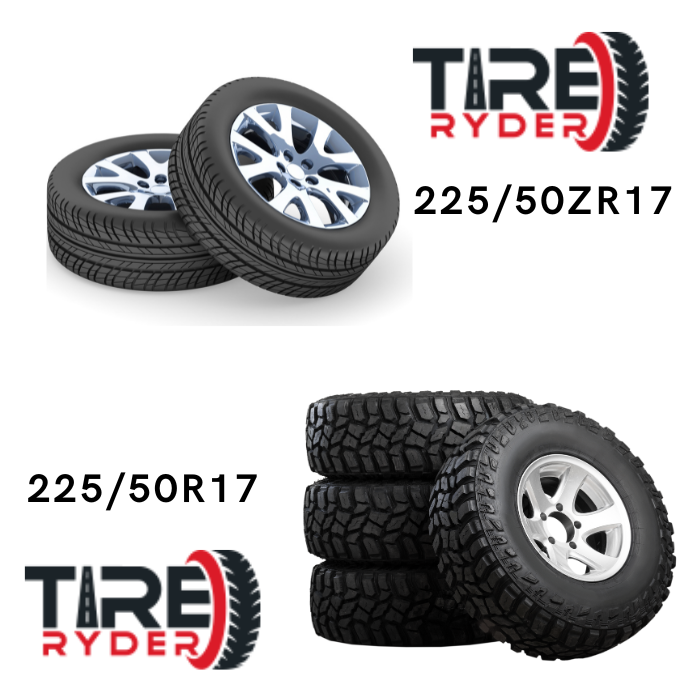While choosing perfect tires for your vehicle, it is important to know certain parameters related to the tires. In general, 225/50ZR17 and 225/50R17 may look similar since they are the same in the width, which is 225 mm, the aspect ratio of 50 %, and the wheel diameter, 17 inches. But, the “Z” added in 225/50ZR17 will mean a totally different tire in terms of performance and usage. This comprehensive guide is a comparison between 225/50ZR17 and 225/50R17 tires, focusing on their performance, uses and adaptability to driving conditions.
About the Tire Size
Every tire has a universal number showing the tire size. Here's what the numbers and letters of tire size means:
225: The width from one side of the tire to the other side in millimeters.
50: Sidewall height shown as a percentage of the tire width, which is 50% of 225 mm or 112.5 mm.
Z: The “Z” in 225/50ZR17 means this tire is designed for higher speed than a 225/50R17 tire.
R: This means it is a radial tire.
17: This is the wheel diameter in inches that the tire has been designed to fit on.
What is Speed Rating?
The speed rating in tires suggests the maximum speed that a tire can handle under proper conditions.
ZR: Traditionally, the “Z” symbol is used to categorize tires that might provide more than 149 mph (240 km/h). Today, "ZR" is a legacy term, and the actual speed rating is determined by additional letters like W or Y as explained below:
W: Engine rated for up to 270 km/h or 168 mph.
Y: Approved for use at speeds up to 186 mph (300 km/h).
R: The absence of the letter “Z” generally shows that the tire has lower speed rating, generally:
H: Ensuring performance is approved for a speed of up to 130 mph (210 km/h).
V: Described for up to 149 mph (240 km/h).
Performance Comparison
Traction and Grip
225/50ZR17:
The high-speed rating of these tires is matched by their performance characteristics. They typically use advanced tread compounds and reinforced construction, offering superior grip on dry and wet roads. So, these tires are ideal for sports cars or performance sedans.
225/50R17:
These tires provide reliable traction for everyday driving but lack the specialized tread compounds found in ZR-rated tires. This is why they are best suited for regular commute and moderate-speed applications.
Handling and Stability
225/50ZR17:
These tires are designed for precise handling and cornering stability. The reinforced construction minimizes deformation under heavy loads and at high speeds, ensuring consistent performance.
225/50R17:
While being adequate for daily driving, these tires show more flex during aggressive cornering, especially at higher speeds.
Comfort and Ride Quality
225/50ZR17:
Due to their stiffer sidewalls and focus on performance, ZR-rated tires may compromise ride comfort, especially on rough roads.
225/50R17:
These tires prioritize ride quality over extreme performance. The softer sidewalls and optimized construction offer better cushioning and absorb road imperfections effectively.
Durability and Longevity
225/50ZR17:
These tires are high-performance, so they have softer tread compounds, which provide better grip on road but also wear out faster, especially during aggressive driving.
225/50R17:
These tires typically last longer due to harder tread compound designed for daily use and moderate speed driving.
Fuel Efficiency
225/50ZR17:
These tires provide enhanced grip and their wider contact patch increases rolling resistance which may lead to slightly lower fuel efficiency.
225/50R17:
Providing less rolling resistance, these tires are usually more fuel-efficient. This makes them ideal for budget conscious drivers.
Weather and Seasonal Performance
Dry Performance
225/50ZR17:
These tires have advanced tread compounds and optimized design that help to provide exceptional dry grip and performance.
225/50R17:
This tire offers good dry performance for everyday use, but does not provide the extreme capabilities of ZR rated tires.
Wet Performance
225/50ZR17:
These tires’ wet performance is about the same as other performance tires, however the narrow tread can increase the risk of hydroplaning.
225/50R17:
These tires are good at evacuating water from tread, and reducing the risk of hydroplaning.
Winter Performance
Unless the tires are winter tires, they can be problematic in winter conditions. Even so, the softer tread of ZR tires may help them in providing more grip on cold, dry roads.
Applications and Compatibility
225/50ZR17
This tire size is commonly used on high-performance vehicles like sports cars, luxury sedans, and performance coupes. For example BMW 3 Series, Audi A4 Quattro, Porsche Boxster, etc.
225/50R17
These tires are suitable for a wide range of vehicles, including sedans, compact SUVs, and family cars including Toyota Camry, Honda Accord, Subaru Outback, etc.
Cost Comparison
225/50ZR17
This tire size is typically more expensive due to advanced construction, higher speed ratings, and specialized compounds.
225/50R17
This tire is more affordable and widely available, making it a budget-friendly option for everyday drivers.
Environmental Impact
225/50ZR17 has shorter tread life and higher rolling resistance contribute to a larger environmental impact. The 225/50R17 tire comes with a longer-lasting tread and lower rolling resistance which make this tire more eco-friendly.
End Note
The choice between 225/50ZR17 and 225/50R17 depends on your driving needs, vehicle type, and priorities. Choose 225/50ZR17 if you drive a high-performance car and frequently travel at high speeds. It will help you to prioritize handling, grip, and precision over comfort and cost. Choose 225/50R17 if you drive a family car, compact SUV, or sedan and prioritize comfort, affordability, and fuel efficiency. By understanding the differences between these two tire types, you can make a well-informed decision to optimize your driving experience.
